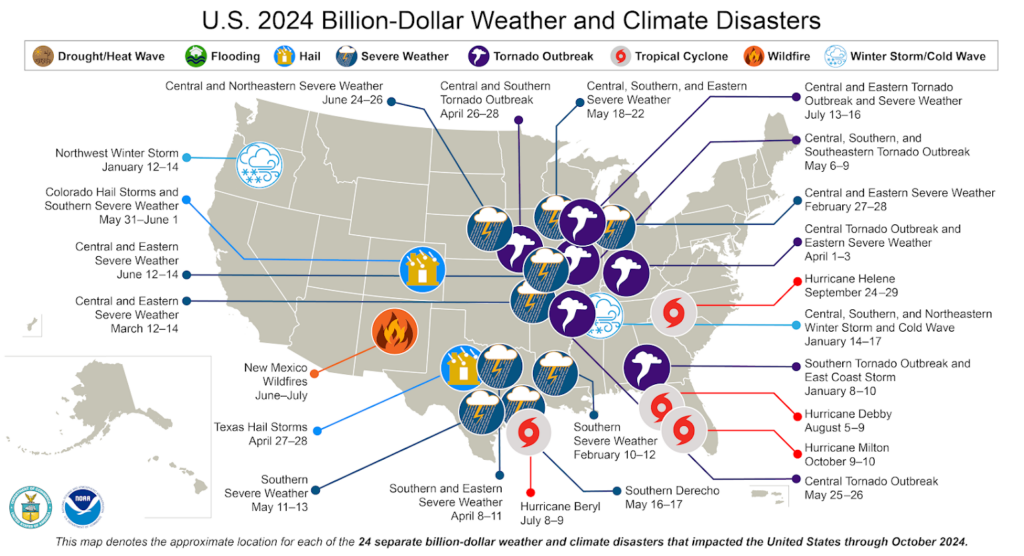The main purpose of this ongoing blog will be to track planetary extreme, or record temperatures related to climate change. Any reports I see of ETs will be listed below the main topic of the day. I’ll refer to extreme or record temperatures as ETs (not extraterrestrials).😉
Main Topic: U.S. September 2024 Record Scoreboard and Climatological Review
Dear Diary. It’s past time for our monthly climatological review because of the effects from Helene on the National Center for Environmental Information in Asheville North Carolina. Thankfully they have recovered. Here on this site, we usually present monthly summaries near the 10th of each month, and each is available by clicking the link below:
https://guyonclimate.com/category/record-scoreboard-climatological-reviews
I’m repeating this mantra every month:
September 2024 using 1901-2000 mean data got ranked by the National Center for Environmental Information for the lower 48 states as 2nd warmest or 129th coolest since records began being kept in 1895 at +3.79°F(2.11°C) above average.
The above data was from:
https://www.ncdc.noaa.gov/cag/national/rankings
September was hot relative to temperature averages for the majority of U.S. states. Most reports of record heat came from the Southwest, south-central states, Midwest, Northeast, and Florida throughout the month. Most reports of record chill came from the Midwest the third week of the month.

Several northern Plains and western states had their hottest Septembers on record.
You can check out record totals for yourself on my NCEI record archives:
NCEI Record Count Archive – Guy On Climate
Here are my two U.S. Daily Record Scoreboards updated through 9/08/2024 (data compiled from the following NCEI site):
https://www.ncdc.noaa.gov/cdo-web/datatools/records
I’m also keeping tabs on record report totals to verify a scientific study I helped to complete in the decade of the 2000s. We’ll eventually see how skewed ratios of record warm to cold reports get by the year 2100, which the study mentions as 50-1 for DHMX vs. DLMN:
Brand new for 2024: I’ve started to add NCEI anomalies (F° departure from 1901-2000 data) on my record scoreboards. I’d like these record scoreboards to be a quick and dirty reference tool and a template for future NCEI record site graphics.


DHMX= Daily High Max Reports. DLMN= Daily Low Min Reports. DHMN= Daily High Min Reports. DLMX=Daily Low Max Reports.
Boldly highlighted red, blue, or purple colored months, such as December 2023 and June 2021, that have ratios of >10 to 1 daily warm low records or <1 to 10 daily warm to low records are either historically hot or cold, most of which have made news. NCEI rankings are for the lower 48 states with the warmest ranking since 1895 of average temperatures being 130 and 1 being the coldest as of 2024. Blue colors represent cold months and red warm. Those months and years with counts close to a 1 to 1 ratio of highs to lows are colored black. All-time record hottest or coldest months and years are boldly colored in purple. NCDC rankings have been color coded (under tabs in each file) such that values of 54 to 74 are black representing neutral months or years (+ or – 10 from the average ranking of 64).
Totals are record reports for the entire United States including all territories minus those from Alaska. I’ve subtracted those from Alaska to get a better representation of what has occurred across the lower 48 states in association with lower 48 state rankings.
September 2024 had approximately a 3 to 1 ratio of record DHMX to DLMN individual record counts, so the color I used for that month was red on the top chart.
September 2024 had approximately a 4 to 1 ratio of record DHMN to DLMX individual record counts, so the color I used for that month was red on the bottom chart.
Due to climate change, we are seeing fewer blue colors on these Record Scoreboards with time.
The average temperature lower 48 state ranking for September 2024 was 129, which was colored red since it was warmer than average.
I color rankings of +10 to -10 from the average ranking for the lower 48 states of 65 black, indicating that these are near average temperature wise. The top warmest ranking for 2024 would be 130 since rankings began in 1895.
We are seeing that so far with only a few days to go that October 2024 has been well above average for most of the country except the Pacific Northwest. October 2024 should be above average for the lower 48 states as a whole and should get pegged as the warmest October on record since 1895.
Interestingly, overall ratios for 2024 are now higher than historic yearly ratios for the 2020s as shown here…which is no surprise given how hot the globe is during this record hot year thanks to climate change:


Here is much more detailed climatology for August 2024 as complied by NOAA:
Assessing the U.S. and Global Climate in September 2024
Second-warmest September on record for the U.S. and Globe; Hurricane Helene caused widespread power outages and catastrophic flash flooding across the Southeast U.S., causing at least 200 fatalities

Courtesy of Sara Veasey, NOAA NCEI
Published
October 24, 2024
Related Links
National Temperature and Precipitation Maps
Climatological Rankings Explained
State of the Climate Summaries
September Highlights:
The release of the September 2024 U.S. and Global Climate Reports was delayed due to significant infrastructure damage near NOAA National Centers for Environmental Information (NCEI) headquarters in Asheville, NC from Hurricane Helene. NCEI is in the process of returning to full operations and anticipates restoration of most data feeds in the near future.
- Temperatures were above average across much of North and South America as well as Europe, but globally, temperatures averaged cooler than what was observed during September 2023, ending the 15-month record streak of record warm global temperatures.
- The year-to-date global temperature was the warmest such period on record, with North America, South America, Europe, and Africa each ranking first.
- The contiguous U.S. was second warmest on record with record warm conditions blanketing portions of the northern Plains, Upper Midwest, and south Florida.
- Year-to-date temperatures across the contiguous U.S. averaged second warmest on record.
- Hurricane Helene was the strongest hurricane on record to strike the Big Bend region of Florida, the deadliest Atlantic hurricane since Maria (2017), and the deadliest to strike the U.S. mainland since Katrina (2005).
- Three new hurricanes (Debby, Helene, and Milton) and one tornado outbreak were added to the 2024 Billion Dollar Weather and Climate Disaster total. The year-to-date total now stands at 24 events — the second-highest event total for this period.
Temperature
The September global surface temperature was 2.23°F (1.24°C) above the 20th-century average of 59.0°F (15.0°C), making it the second warmest September on record. This value was 0.34°F (0.19°C) cooler than what was observed during September 2023. According to NCEI’s Global Annual Temperature Outlook, there is a 99.8% chance that 2024 will rank as the warmest year on record.

The average temperature of the contiguous U.S. in September was 68.6°F, 3.8°F above average, ranking second warmest in the 130-year record. Generally, September temperatures were above average across much of the contiguous U.S., with near average temperatures observed from portions of central Texas to the central Atlantic Coast. Arizona, Wyoming, North Dakota, South Dakota, and Minnesota each ranked warmest on record for September.

Other Highlights
- Arctic sea ice extent was the sixth smallest in the 46-year record at 1.69 million square miles. Antarctic sea ice extent was 6.59 million square miles, the second lowest on record.
- The Northern Hemisphere snow cover extent in September was slightly below average. Snow cover over North America was below average (by 320,000 square miles); Eurasia was slightly above average (by 90,000 square miles).
- Global Precipitation in September was near the long-term average. Notably, much of the Sahara desert had its wettest September on record, driven by the rare passage of an extratropical cyclone on September 7-8.
- The U.S. has sustained 400 separate weather and climate disasters since 1980 where overall damages/costs reached or exceeded $1 billion (including CPI adjustment to 2024). The total cost of these 400 events exceeds $2.785 trillion.
- Cost estimates for Hurricanes Helene and Milton have yet to be determined and are not part of the cost total at this time.
- The 2024 Billion Dollar Weather and Climate Event Disaster total of 24 events through mid-October is second only to the 27 events reported by this time last year.

This monthly summary from NOAA’s National Centers for Environmental Information is part of the suite of climate services NOAA provides to government, business, academia and the public to support informed decision-making. For additional information on the statistics provided here, visit the Climate at a Glance and National Maps webpages. For a more complete summary of global climate conditions and events, explore our Climate at a Glance Global Time Series.
Here are more “ETs” recorded from around the planet the last couple of days, their consequences, and some extreme temperature outlooks, as well as any extreme precipitation reports:
Here is More Climate News from Thursday:
(As usual, this will be a fluid post in which more information gets added during the day as it crosses my radar, crediting all who have put it on-line. Items will be archived on this site for posterity. In most instances click on the pictures of each tweet to see each article. The most noteworthy items will be listed first.)